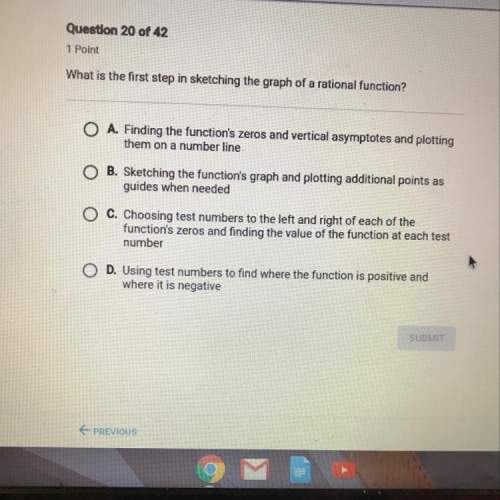
Mathematics, 13.12.2021 08:10 bvallinab
Type the correct answer in each box. Use numerals instead of words. If necessary, use / for the fraction bar. A hotel survey showed that nearly 30% of the guests staying at the hotel were there for personal reasons. The remainder of the guests were at the hotel on business. Use the table of randomly generated letters to answer the questions about this scenario. The letter P represents personal reasons, and B represents business reasons. BBB PBB BPB PPB BBP BBP PBB PPB PBB BBP BBP BPB BBB BBB BBB PPB BPB PBP BPB BBP BPB PBP PPB PBB BBB Based on this data, the estimated probability that exactly two of the three guests randomly picked were not there for personal reasons is . The estimated probability that it takes at least four guests to find one who is staying for personal reasons is .

Answers: 2


Other questions on the subject: Mathematics

Mathematics, 21.06.2019 18:30, bellabarfield4286
The u-drive rent-a-truck company plans to spend $13 million on 320 new vehicles. each commercial van will cost $25 comma 000, each small truck $50 comma 000, and each large truck $80 comma 000. past experience shows that they need twice as many vans as small trucks. how many of each type of vehicle can they buy?
Answers: 1

Mathematics, 21.06.2019 20:20, oofoofoof1
Sample response: if the graph passes the horizontaline test, then the function is one to one. functions that are one to one have inverses that a therefore, the inverse is a hinction compare your response to the sample response above. what did you include in your explanation? a reference to the horizontal-line test d a statement that the function is one-to-one the conclusion that the inverse is a function done
Answers: 2

Mathematics, 21.06.2019 23:30, bbby2
Aprisoner is trapped in a cell containing three doors. the first door leads to a tunnel that returns him to his cell after two days of travel. the second leads to a tunnel that returns him to his cell after three days of travel. the third door leads immediately to freedom. (a) assuming that the prisoner will always select doors 1, 2 and 3 with probabili- ties 0.5,0.3,0.2 (respectively), what is the expected number of days until he reaches freedom? (b) assuming that the prisoner is always equally likely to choose among those doors that he has not used, what is the expected number of days until he reaches freedom? (in this version, if the prisoner initially tries door 1, for example, then when he returns to the cell, he will now select only from doors 2 and 3.) (c) for parts (a) and (b), find the variance of the number of days until the prisoner reaches freedom. hint for part (b): define ni to be the number of additional days the prisoner spends after initially choosing door i and returning to his cell.
Answers: 1
You know the right answer?
Type the correct answer in each box. Use numerals instead of words. If necessary, use / for the frac...
Questions in other subjects:

Computers and Technology, 29.01.2021 19:30


Mathematics, 29.01.2021 19:30





Mathematics, 29.01.2021 19:30

Mathematics, 29.01.2021 19:30




